As wildlife habitats are in decline it’s more important than ever to make space for wildlife in our gardens or around our homes. You can find a whole range of simple and easy ideas for making a home for wildlife in your garden below. Even if you don’t have a garden you can make use of a window box or doorstep plant pots to plant wildflowers or hang insect, bird or bat boxes from a wall, fence or window.

1. Let it grow wild
One of the simplest things you can do is let areas of grass grow long and wild in your garden. Grass is an amazing and much over looked plant that provides food, shelter and homes for a wide variety of wildlife as well as producing oxygen, absorbing carbon, preventing soil erosion, filtering water and breaking down harmful microbes and pollutants. We’ve already found that leaving areas of long uncut grass growing in the garden has massively increased the variety and amount of insects and wildlife we find. May in particular is an important time to leave the lawn to grow and flourish as this is often when any wild flower plants that have been hiding in the grass begin to flourish and flower.

Insects and amphibians will enjoy the cool shade and moisture the long grass retains, and any wildflowers that flourish amongst uncut grass will bring an increased numbers of bees, beetles and butterflies. Birds and small mammals will also feed on the grass seed and hedgehogs, bats and predators like owls, frogs and foxes will all benefit from the increased number and diversity of mini beasts.
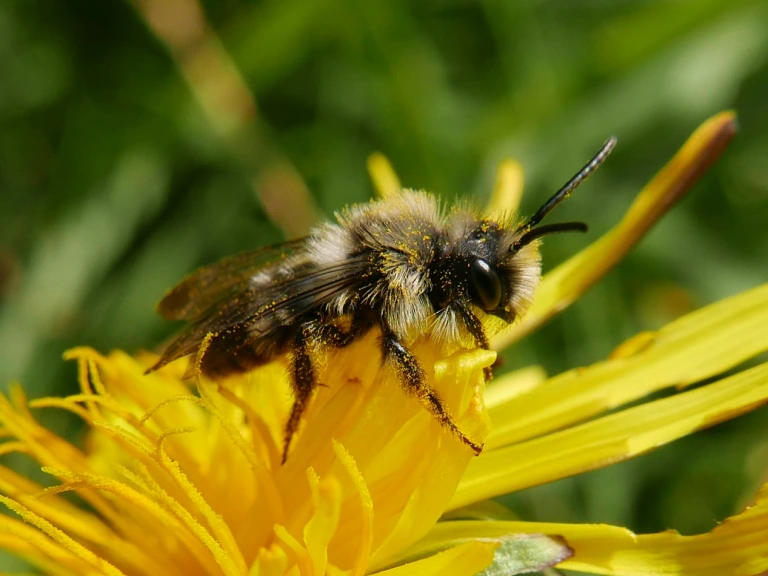
How about leaving a border of long grass all around the edges of your garden to provide a safe corridor for wildlife to move through. You could even sow wildflower meadow mix into the grass or even plant mini meadows in pots or a window boxes.
2. Grow wildflowers and pollinator friendly plants
Did you know that a third of the food we eat comes from plants that rely on pollination? Even medicines and materials like morphine, aspirin and cotton are derived from pollinated plants? Yet pollinator species across the world are in drastic decline due to widespread pesticide use and the loss of habitats.
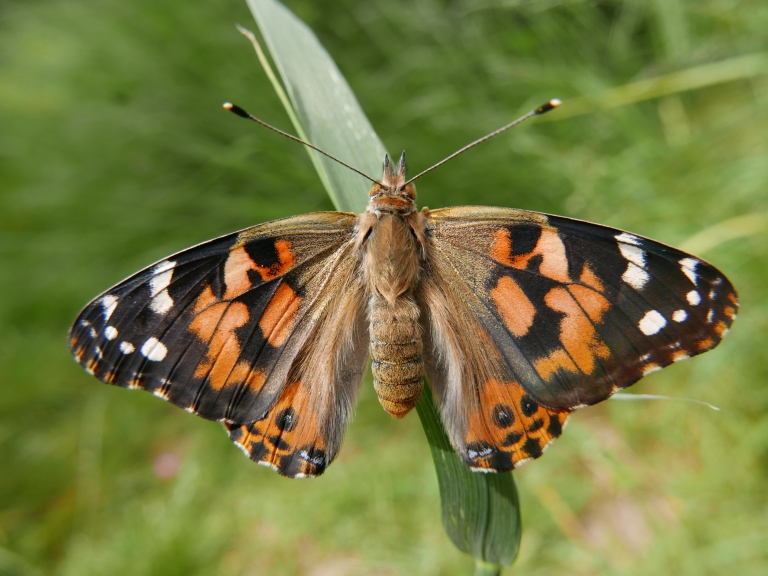
This is why its so important to help pollinators like bees, butterflies, moths, hover flies and beetles by providing food and egg laying spaces for them. You can easily do this by growing as many wildflowers and pollinator friendly plants and flowers as you can, thereby provide a source of food for all year round as well as giving them the plants they need to lay their eggs on.

You can find handy lists of pollinator friendly plants via the links below.
- Click here for a list of nectar rich plants and flowers for butterflies.
- Click here for a list of plants that provide food for butterfly caterpillars.
- Click here for a list of nectar rich and night scented plants and flowers for Moths.

3. ‘Weeds’ are such a vital part of our ecosystem so let them grow!
It’s a shame that so many important wildflowers and plants are considered unwanted “weeds” that are often pulled up or killed off by chemicals. Up until the 1800’s it was common for people to leave edible and medicinal wild flowers in their gardens like dandelions, fennel and sorrel.

Dandelions are beautiful wildflowers that provide an important source of food for pollinators. They flower early in the year long before any other plants. Bees, butterflies, and many other insects feed on the pollen and nectar, and caterpillars of butterflies and moths feed on the plants. Some species of bird even feed on the seeds. The entire plant is also edible for humans, you can eat the leaves, stems, flowers, and roots of dandelions.

Stinging nettles also provide an important source of food for wildlife. The caterpillars of several species of butterfly and moth rely on the plants for food, ladybirds lay their eggs on the leaves, bees and other pollinators feed on the nectar from the flowers and some species of bird even feed on the seeds. Humans throughout history have also relied on nettles for food, clothing, dye and rope.
Ivy is also a vital source of food late in the year for many pollinators long after the last flower has bloomed. Resist the urge to cut back Ivy in the autumn or winter as this is when it flowers.
4. Dig a ditch
Digging a small ditch in your garden will create a whole new micro habit for wildlife to thrive in. Ditches are naturally more sheltered, shaded, cooler and moist. They provide safe corridors for wildlife like hedgehogs to move in and give amphibians, mammals and insects a much needed cool habitat to shelter in during hot weather.

All you need to do is dig a long hole along the border of your garden, it can be as deep or as shallow as you like but do remember to make the sides sloping so wildlife can get in and out. You also want to make sure its not somewhere where it will be a trip or fall hazard for humans. We added some wild flower seeds to our ditch to provide extra food and shelter when they grow.
5. Provide nesting boxes and materials for birds
February is often the beginning of nesting season for most birds but the nesting period can actually last till August and some birds like wood pigeons will actually nest all year round. It’s very important not to cut back hedges or trees or disturb potential nesting sites during nesting seasons.

Different types of bird will choose and use different materials and methods to build their nests. Many birds use twigs, grass and feathers to build them, some use mud, moss and fur and others like Chaffinches even use spider webs.
You can help nesting birds by putting up bird boxes before or after the nesting season. You could also leave out natural fibres and pieces of plant materials for birds to collect. Just please don’t leave out human or pet hair as both can be contaminated with chemicals and birds can become entangled in them.
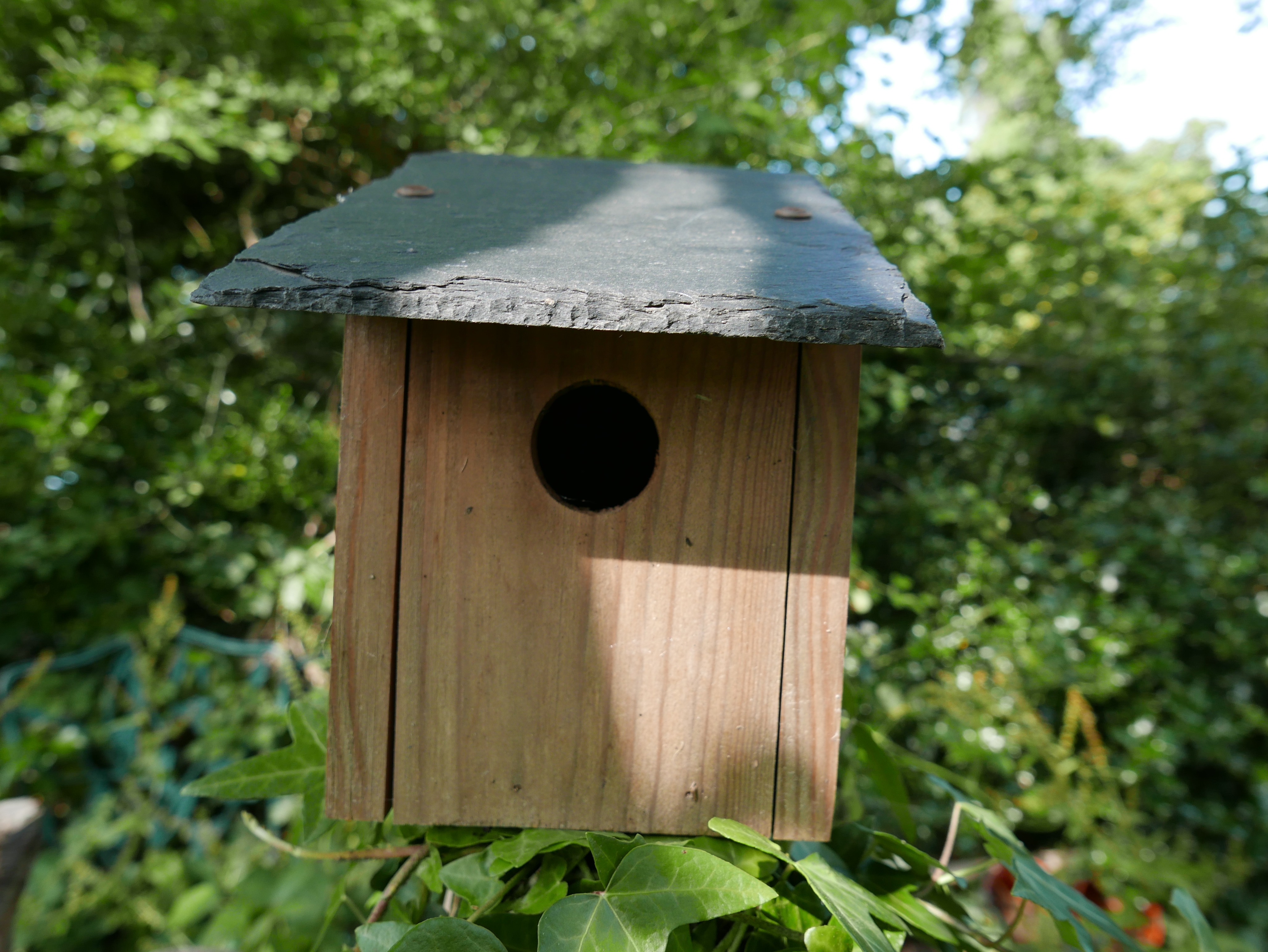
6. Make an insect shelter
Creating shelters for insects is a great way to increase the diversity of wildlife in your garden. Many insects benefit from having shelter and a healthy population of insects will also provide a ready source of food for other wildlife such as hedgehogs, frogs, toads, slow worms, bats and birds. They can be made using just recycled and found natural materials and you don’t have the room or a garden for a big insect shelter you could always make a mini one to place in a window box or hang from a wall or fence.
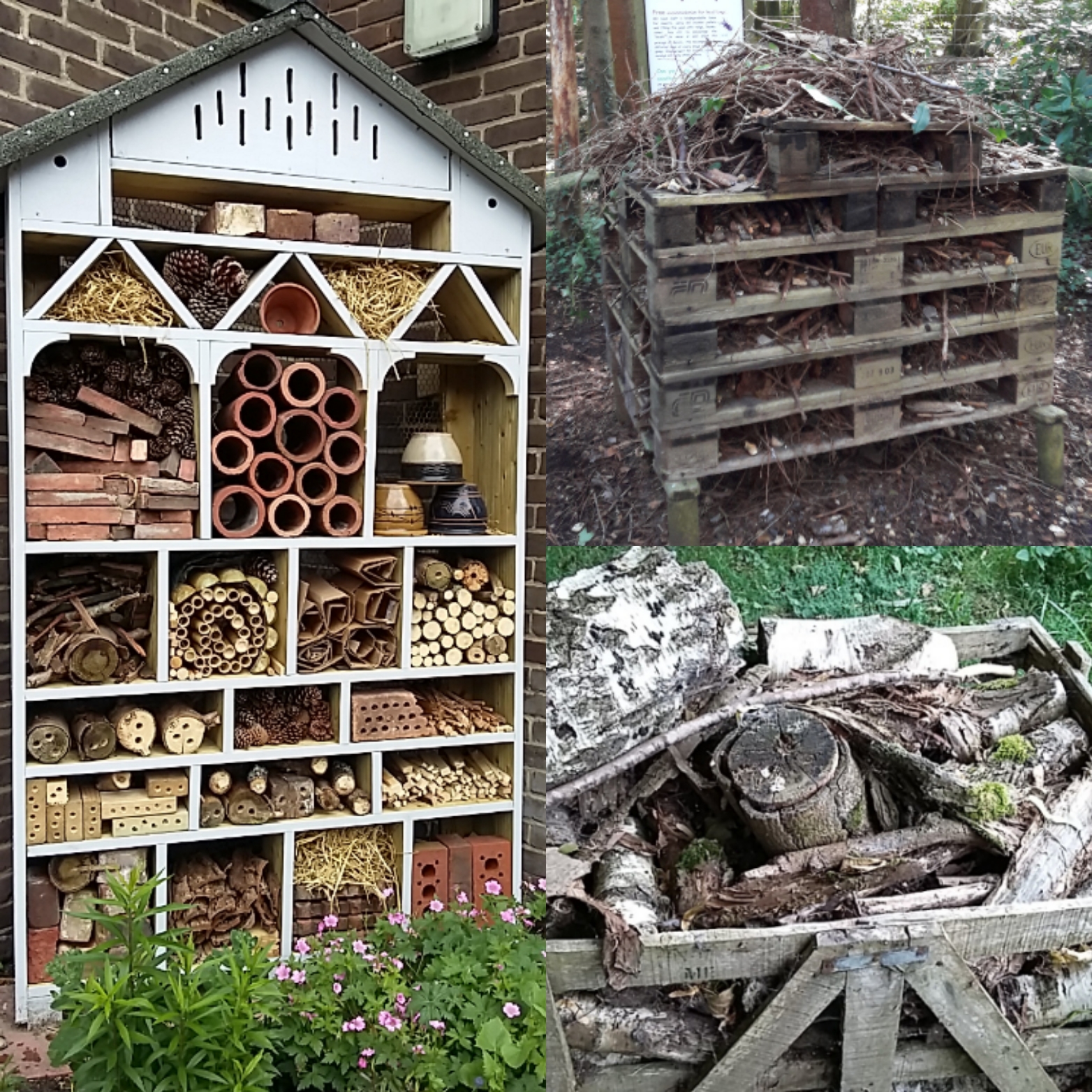
An insect shelter can be as simple as a pile of logs or a plant pot full of sticks or as grand as a multi layered bug hotel. Collecting the materials to make an insect shelter is an enjoyable activity in itself. How about looking around in the garden or on a nature walk to find materials you need to use.
Hollow bamboo canes, small clusters of tubing, bricks with holes in and wood with natural or drilled holes are all brilliant materials that create nesting sites for solitary bees. Unlike Honey bees solitary bees do not live in hives. As the name suggests they mostly live alone making solitary little nests in the ground or holes in walls and trees.

Old wood like logs, branches, planks, wood, pallets, crates and sticks create the perfect conditions as they rot down for insects that like damp, dark places, like ground beetles, woodlice, centipedes and earwigs. Just make sure any wood you use is paint free and doesn’t have any loose or sharp nails or staples sticking out. Layered rocks, stones, pebbles, bricks, paving slabs and plant pots close to the ground all help create cool shady nooks and hiding places for creatures like frogs, toads, slow worms, lizards, snakes and spiders.
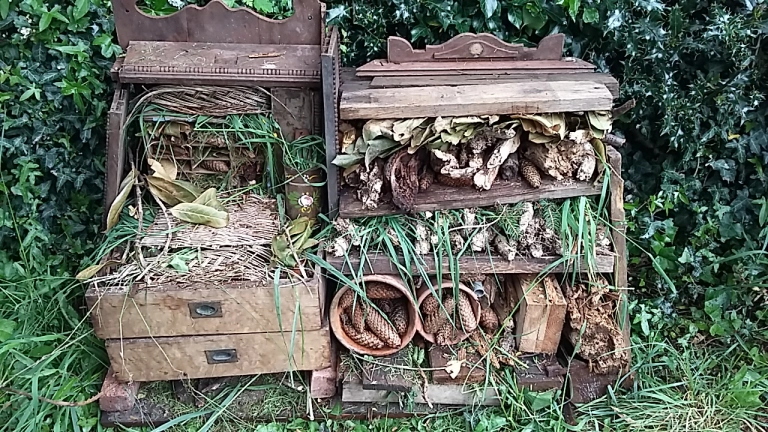
You can pack plant pots and the larger spaces in your insect house with other smaller natural materials like pine cones, cut grass, leaves, old dried ivy stem clusters, straw, hay, moss, twigs, old bunches of flowers and a sprinkling of loose earth to encourage the smaller insects. Remember to leave lots of spaces and gaps at the bottom for larger wildlife to hide in and under.
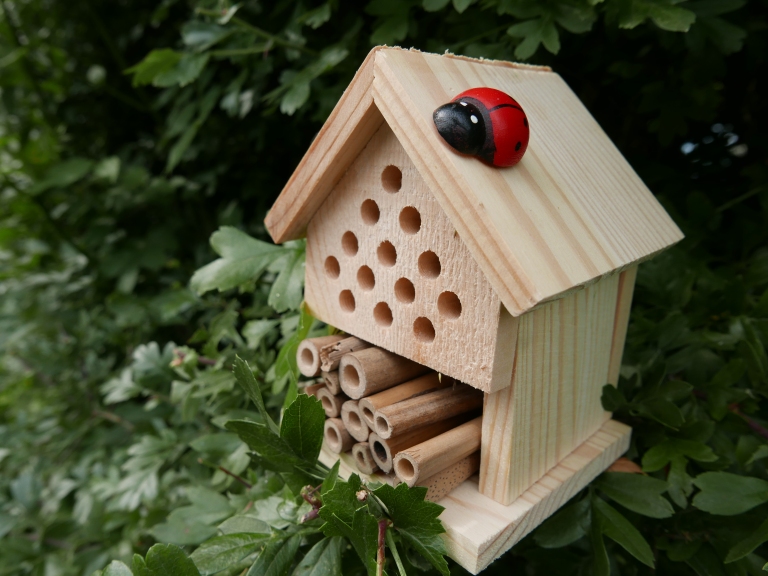
To make a smaller insect house that you can place on a window box, wall, fence or hang from a tree you will need an old tin, mug or a flower pot. You can have fun decorating the outside with paint and pens on the outside and then fill them with natural materials like sticks, pine cones, cut grass, leaves, moss and hollow bamboo canes. There are also many commercial varieties you can buy as well if you prefer which you can also have fun painting and decorating.
7. Create micro habitats and mini gardens
If you don’t have a garden or only have a small outdoor area like a doorstep, porch or side alley you can still create micro habitats and mini gardens using planters, pant pots window boxes. You can also create a variety of mini habitats in a garden in the same way. You can easily grow a mix of wildflowers, wild grasses with a mini shrubs in each planter to provide food and shelter for variety visiting insects, birds and wildlife.

8. Enrich the soil in your garden.
Did you know that soil is alive? A single teaspoon of healthy soil can contain over 100 million microorganisms and a quarter of all Earth’s species exist in soil.. Healthy soil also prevents flooding and stores vast volumes of carbon preventing it from escaping into the atmosphere. Amazingly there is more carbon captured in the earths soil alone than in all the atmosphere and the world’s trees and plants combined.

We take soil for granted yet 95% of our food production relies on it, especially top soil which takes an incredibly long time to form. Just 2cms of top soil can take over 500-1000 years to form and yet we are destroying it 10-40 times faster than it can be replenished. Soil that is not covered by vegetation is particularly vulnerable to pollution, erosion and flooding which kills the organisms living within it making the soil itself essentially dead.
You can easily enrich and protect the soil in your garden by making your own home compost (see below), not using pesticides and chemicals and by planting plants that help put nitrogen and carbon back into the soil. Clover (white and yellow trefoil) is a great plant to introduce into lawns as it improves the soil and also provides a source of food for pollinators.

Peas and beans (legumes in general) are also brilliant plants to grow because the are deep rooted and draw up nutrients from deeper in the soil as well as putting nitrogen and carbon into the soil improving the fertility. Trees really help as well as they are deep rooted, add carbon and nitrogen to the soil and improve drainage and soil structure as well as providing a source of food and shelter to a vast variety of wildlife.
9. Make a wormery and create your own compost
Did you know earthworms play a vital role in our environment and eco system? They decompose organic matter by feeding on it and recycling the nutrients back into the soil as food for plants. Worm poo (or castings) can contain up to 5 times more nitrogen, 7 times more phosphorus, and 1000 times more beneficial bacteria than regular soil. As they move and burrow through the earth the worms also help to loosen, mix and aerate the soil around them. This improves the structure of the soil allowing water to drain through more easily and circulating oxygen through the soil which is vital for soil microorganisms as well as plants.

To start a composting wormery you will need a large plastic container or tub as well as soil, stones and or sand, vegetable peelings and grass or leaves. First you need to drill holes into the base of the container and then place it on bricks to allow any liquid to drain off. Next line the bottom of the wormery with stones and then covered it with a small layer of stones or sand. This layer of stones and sand is to absorb any excess liquid from the rotting plant material as it breaks down. Now fill the rest of the wormery with soil making sure to leave enough room at the top for a layer of food for the worms.

Now you can have fun going on a worm hunt in the garden to find earthworms hiding under logs, stones or plant pots. Pretty please remind children to be very gentle with the worms and try not to handle them too much. As soon as you find a worm place it in your wormery and sprinkle over a fine layer of soil to keep them cool and moist. Next you need to place a source of food for the worm’s in the wormery. Most types of plant matter and vegetables can go into the wormery to be composted. However the worms do not like acidity so avoid putting in onions and citrus fruits. And finally cover your wormery with cardboard or newspapers to keep the flies out but allow air in. Now you can sit back and let your worms turn your garden and vegetable waste into compost.
10. Grow or plant a tree
Trees are such an important part the worlds ecosystem, they create oxygen, soak up carbon dioxide, prevent soil erosion, retain nutrients in the soil and provide food and shelter for wildlife. Thousands of different species depend on trees from birds, mammals and invertebrates to reptiles, fungi, mosses and lichens. Even when a tree dies it still plays a vital role in the ecosystem. The dead wood creates nitrogen for the soil and provides habitats for a variety of animals.
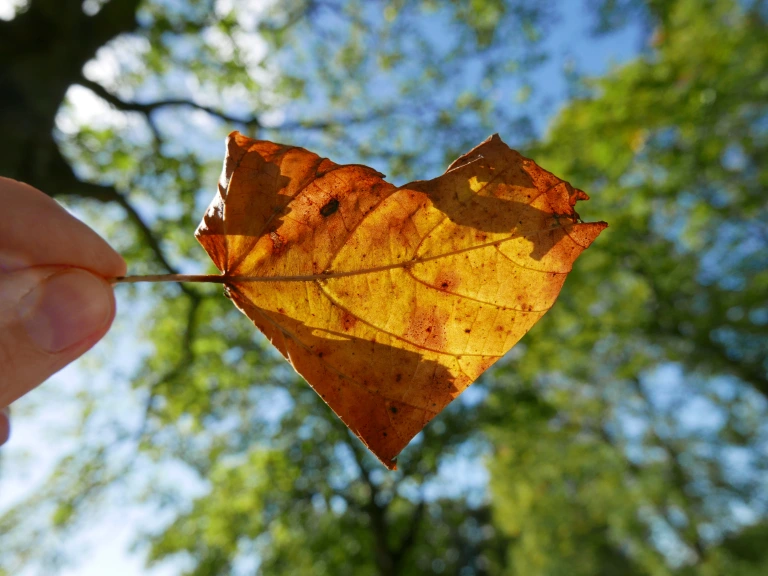
It is so easy to buy and plant a tree sapling, You can also try growing a tree from seed like we did with acorns, conkers (photo below) and pines, this take a little patience to grow but it is incredibly rewarding when you manage to grow a little seed into a tree sapling. You may never see the fully grown tree yourself as you will have probably moved house long before then. But there is a wonderful quote that says “A society grows great when old men plant trees whose shade they know they shall never sit in.”

11. Grow a hedge
Hedges also provide fantastic shelter, homes, food, nesting sites for a variety of wildlife from birds and mammals to insects, amphibians and reptiles. The best kinds of hedges are the ones that are made up of a variety of native trees and shrubs as they provide a wider variety of habitats and food sources. Hazel, hawthorn, crab apple, blackthorn, alder, spindle and field maple all make great hedge environments. You can also add in climbing plants like ivy, clematis or bramble to create additional sources of food and egg laying habitats for pollinating insects.

12. Make an amphibian and reptile shelter
You can easily create simple shelters for amphibians and reptiles to hide in from predators using recycled garden materials. Layering piles of rocks, stones, pebbles, bricks, paving slabs and plant pots close to the ground all help create cool shady nooks and hiding places for amphibians and reptiles like frogs, toads, slow worms, lizards, newts and snakes.
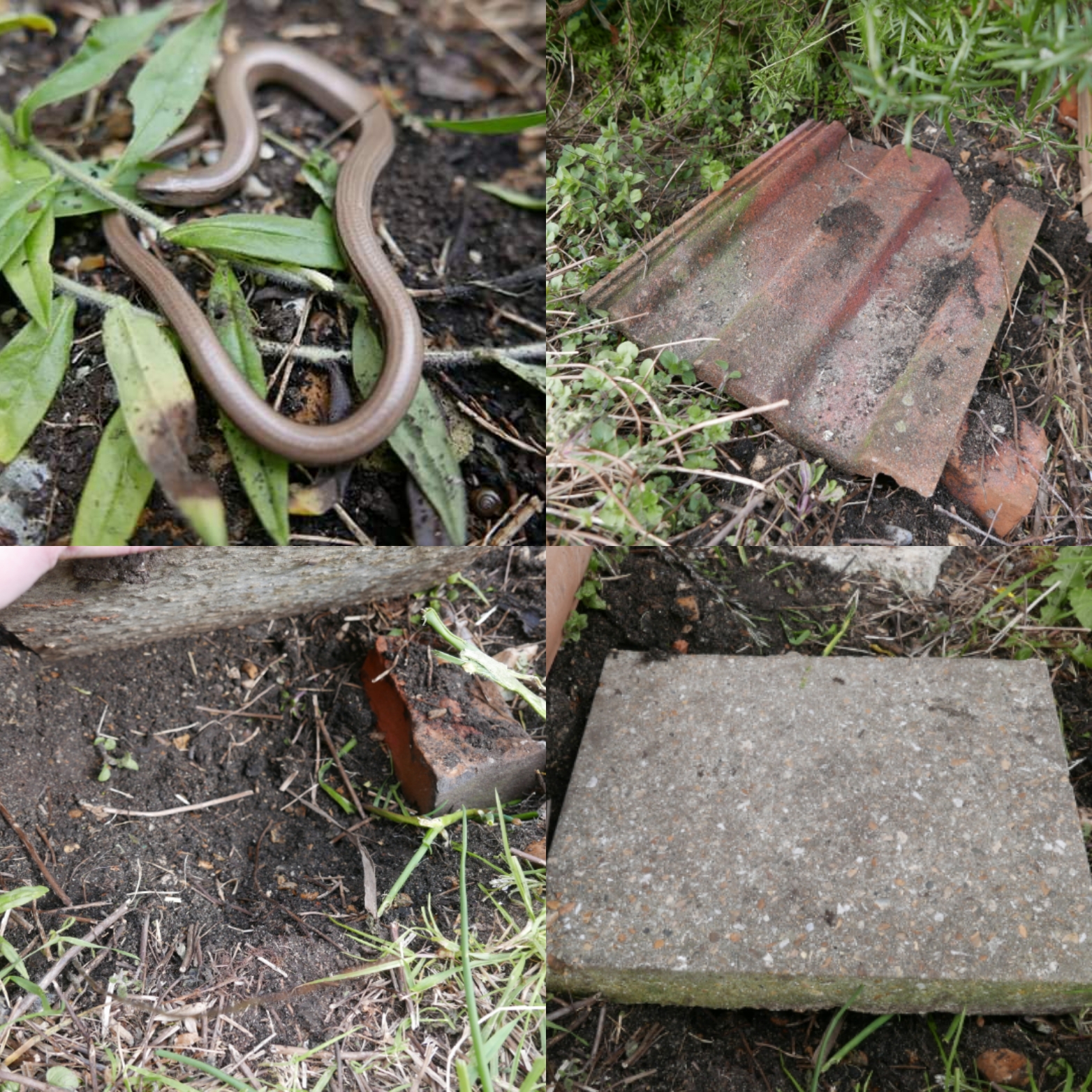
Old terracotta plant pots also make perfect amphibian and reptile shelters. You can either break them in half or half bury them in the ground to create a shady cool hideaway. Just make sure they aren’t places anywhere were they might become a trip hazard.

You can also create an underground den for amphibians to hibernate in during the winter. Amphibians like to hibernate in dark, damp safe spaces underground. You can easily dig a hole in the ground that’s roughly 30-40cm deep. Line the hole carefully with logs, sticks and stones to create a series of mini spaces and holes for them to hide in. You want it to be stable so it doesn’t fall on any creatures but you also want to leave space for them to move about in.

Next partially cover over the top of the hole using half of an old flower pot or a plank of wood. You want to cover it enough to keep the worst of the weather and predators out whilst also leaving room for smaller animals to enter. If you are using a flower pot you could loosely line it with long grass to provide extra shelter. Finally cover over the top (leaving the entrance hole) with soil and sprinkle on some grass or wild flower seeds.
13. Make a wildlife pond
Ponds are important source of food, water and shelter for many animals and insects. From amphibians like frogs and newts, to aquatic mini beasts and insects like dragon flies (which begun their lives as underwater nymphs) and bats and birds that eat some of the insects. Making a small wildlife pond is very simple, all you need is a watertight container (or waterproof sheeting). Pond plants, rain water, soil, stones rubble and bricks.

Safety note: Open water of any kind can present a drowning risk for small children and pets. Please make sure your pond is secured in some way (with netting or barriers) so children and pets are prevented from accessing the water.
The first thing you need to do is dig a hole big enough to fit your container in. You then need to put a base of soil into the container to provide nutrients for the pond plants to grow in, and somewhere for water insects to burrow.
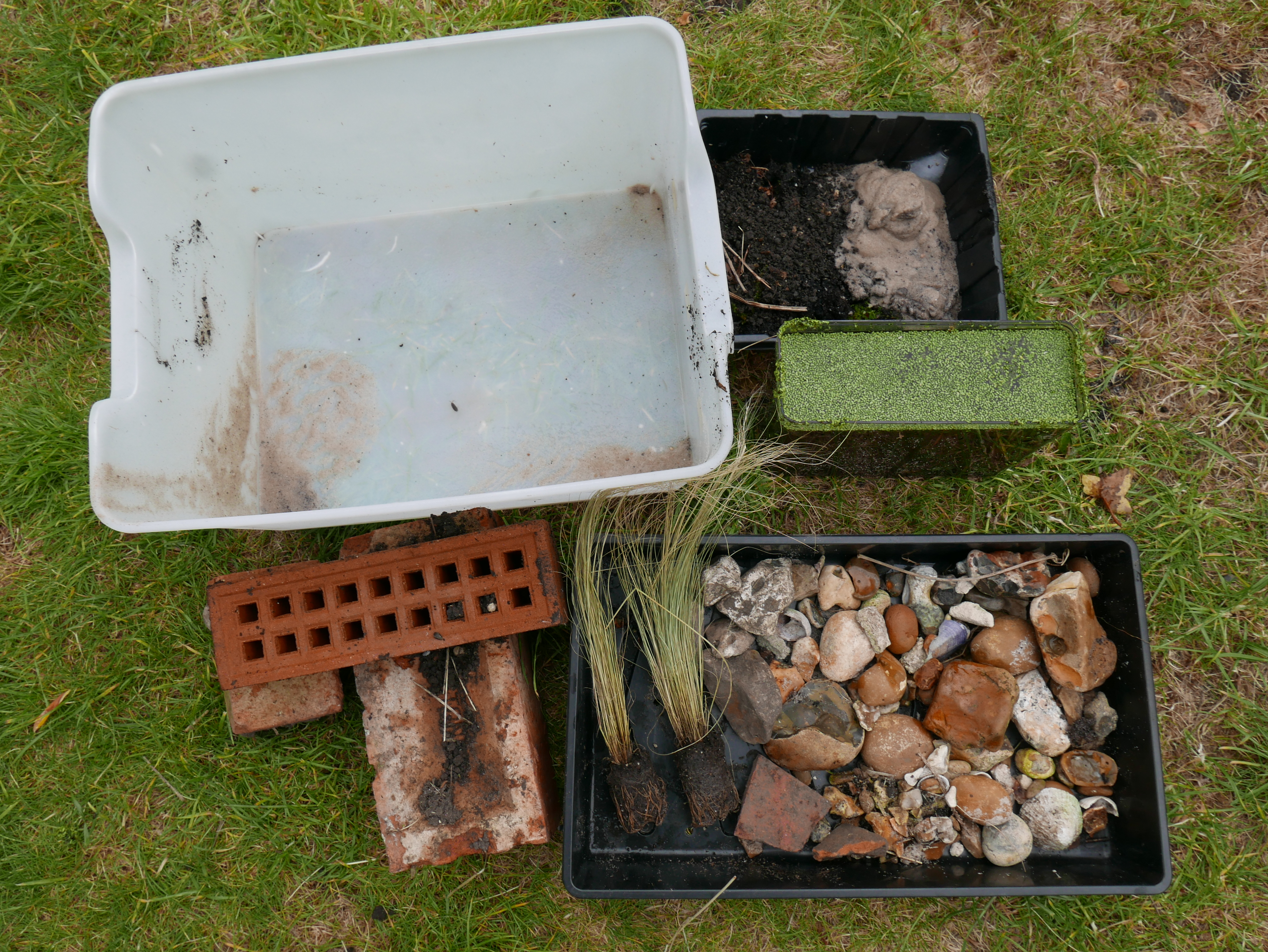
Next you need to make sure there is a basic staircase at one end to create an easy escape route for any wildlife that may fall in the pond. (To prevent accidental drowning). You could also add in some rubble, stones and old small terracotta plant pots to provide hiding places for aquatic minibeasts.

Now you can fill the pond with rain water or water from a natural local source (that you can safely collect in buckets ) It’s best use natural water as it won’t contain any of the fluoride or other chemicals may be present in tap water.

The final and most important thing to put in your pond are aquatic plants that will create oxygen in the water and provide a source of food and shelter for pond creatures and insects. We used duck weed as our tadpoles love it and it creates a nice cover over the pond to give them lots of shelter.

Another way to provide shelter is to layer piles of rocks, stones, pebbles, bricks, paving slabs and plant pots close to the edge of the pond to help create cool shady nooks and hiding places for amphibians and other wildlife to shelter in and hide from predators. You could also plant wild flowers and flowering shrubs round the pond to encourage pollinating insects and provide additional shelter for wildlife.

Now you can leave your pond to flourish and grow. Just keep an eye on it throughout the seasons to see what wildlife has moved in or is stopping by to visit your pond.
14. Make an owl nesting boot
You can also get creative and make an owl nesting site or shelter using just an old wellington boot and a handful of sawdust, wood shavings or dried grass or straw. Did you know the reason owls fly silently is the same reason they don’t have waterproof feathers? Most birds coat their feathers in oil to make them waterproof (they do this by rubbing their beaks along a gland near their tails and then preen along the feathers to coat them). However this makes the feathers stiffer and catch the air when they fly, which is why ducks flap so noisily. By not coating their wings in oil owls can fly silently which makes them much more successful hunters, unfortunately it also means they get very soggy when it rains!

To make an owl nesting site first take an old welly boot and drill or poke small holes in the sole of the boot. These holes will allow rainwater and any other liquids to drain from the bottom of the boot. Next place a small layer or handful of sawdust, wood shavings or dried grass or straw into the bottom of the boot to provide nesting material. Finally Find a suitable sheltered nearly horizontal tree branch to tie the boot to securely using strong string or wire.

If you are lucky enough to get wild birds nesting in your garden or birdbox then please don’t disturb the nest just please just quietly observe them it from a distance. Disturbing the nest might cause the parents to abandon the eggs. You can clean out the nesting site once the chicks have fledged and fully left the nest but please wait a month or two first to make sure there isn’t a second brood. The Woodland Trust have a great free guide to identifying wild bird eggs here.
15. Grow a bat bog garden
There are over 1100 species of bat in the world, 18 of which you can spot in the UK. Bats use up a tremendous amount of energy flying about so they need to consume a huge amount of insects each night, a common Pipistrelle bat for example can eat over 3000 small insects in one night. They do a fantastic job of keeping down populations of pest insects such as mosquitos.
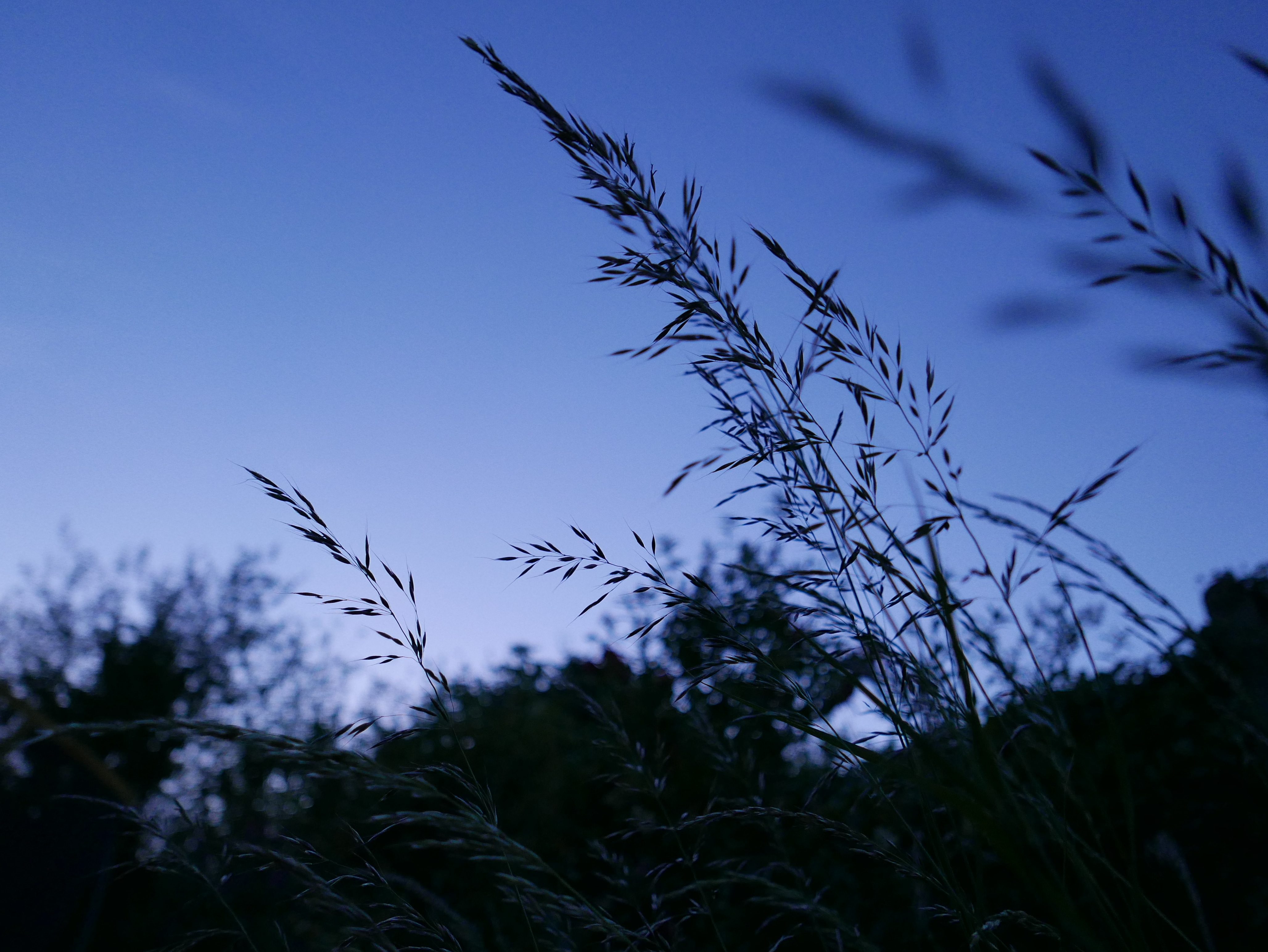
You can help bats by providing night scented plants that attract pollinating insects like moths, putting up bat nesting boxes or by creating a bog garden which creates the perfect habitat for insects bats like to eat. You either create a bat bog garden using planters or by creating a boggy area directly in the garden.

To make a boggy garden or planter you will need to line the base of the planter or a dig a wide large hole in the garden and then line it with an old paddling pool or a plastic liner for a pond. Make sure the lining has a few tiny holes for drainage. The idea is to retain moisture and create damp boggy ground but not let it become over flooded. Next cover the liner with soil and water it with rainwater to make it nice and damp. Finally plant some marshy plants like Marsh-marigold, Yellow Iris, Creeping Jenny, Meadowsweet, Snake’s-head-fritillary, Plaintain Lily, Water Avons or Hemp-agrimony.
16. Make a hoverfly lagoon
Hoverflies are just as important as bees, butterflies and beetles when it comes to pollination. Yet not that many people seem to be aware of the important environmental role that these beautiful creatures play, helping with the pollination of flowering plants as well as protecting crops from aphid infestations.
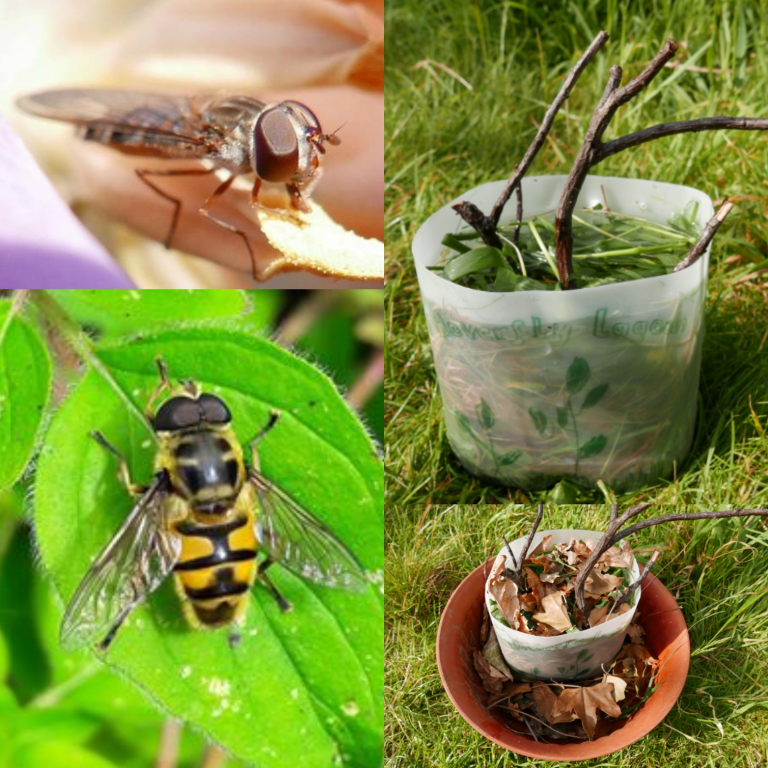
This is where you can help! As we are losing more of our wild spaces and natural habits hoverflies are also losing egg laying spaces and sources of food. By simply creating a hoverfly lagoon you can provide the perfect nursery site for hoverflies that like to lay eggs and larvae in pools of water like ‘rot holes’ in trees. You can find a full guide to making a hover fly lagoon here.
17. Provide water for wildlife
It’s important to provide water for wildlife on hot days and during droughts and freezing winters by putting out bowls or dishes of water. Just remember to clean them regularly and change the water if it becomes fouled or dirty.
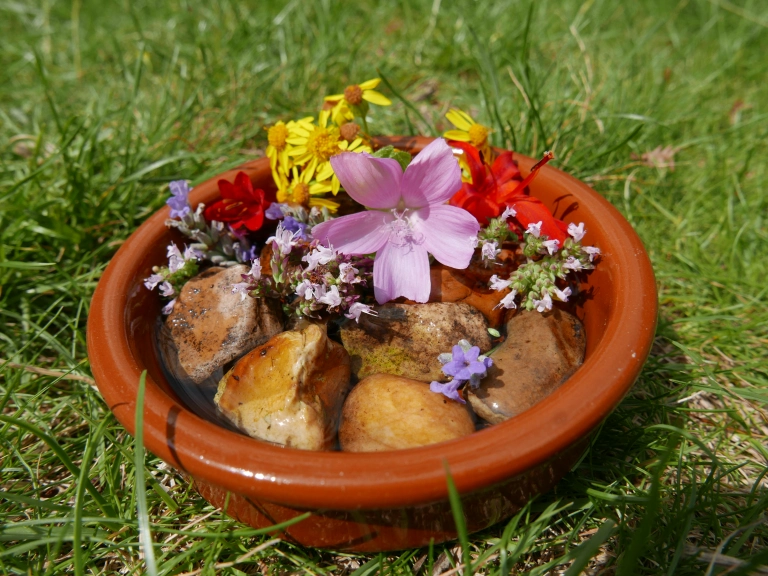
You can also create a water station for pollinators. All you need is a shallow dish or tub lined with pebbles to give the insects something to stand on so they don’t drown and enough water to fill the base of the dish/tub without covering the pebbles. It’s important not to put sugar solution in the water station as this can spread disease and also prevent bees and butterflies from properly gathering nectar.
18. Make bird feeders
During the cold winter months food can be much harder to find for birds. You can help get them through the winter by providing food, water and shelter in your garden. One of the ways we like to help is by making pine cone bird feeders. You can collect pine cones on a woodland walk or by looking in your local park. You will also need wild bird seed and string and a source of fat which can be either peanut butter, lard or a vegetarian lard substitute like Trex or Crisco.
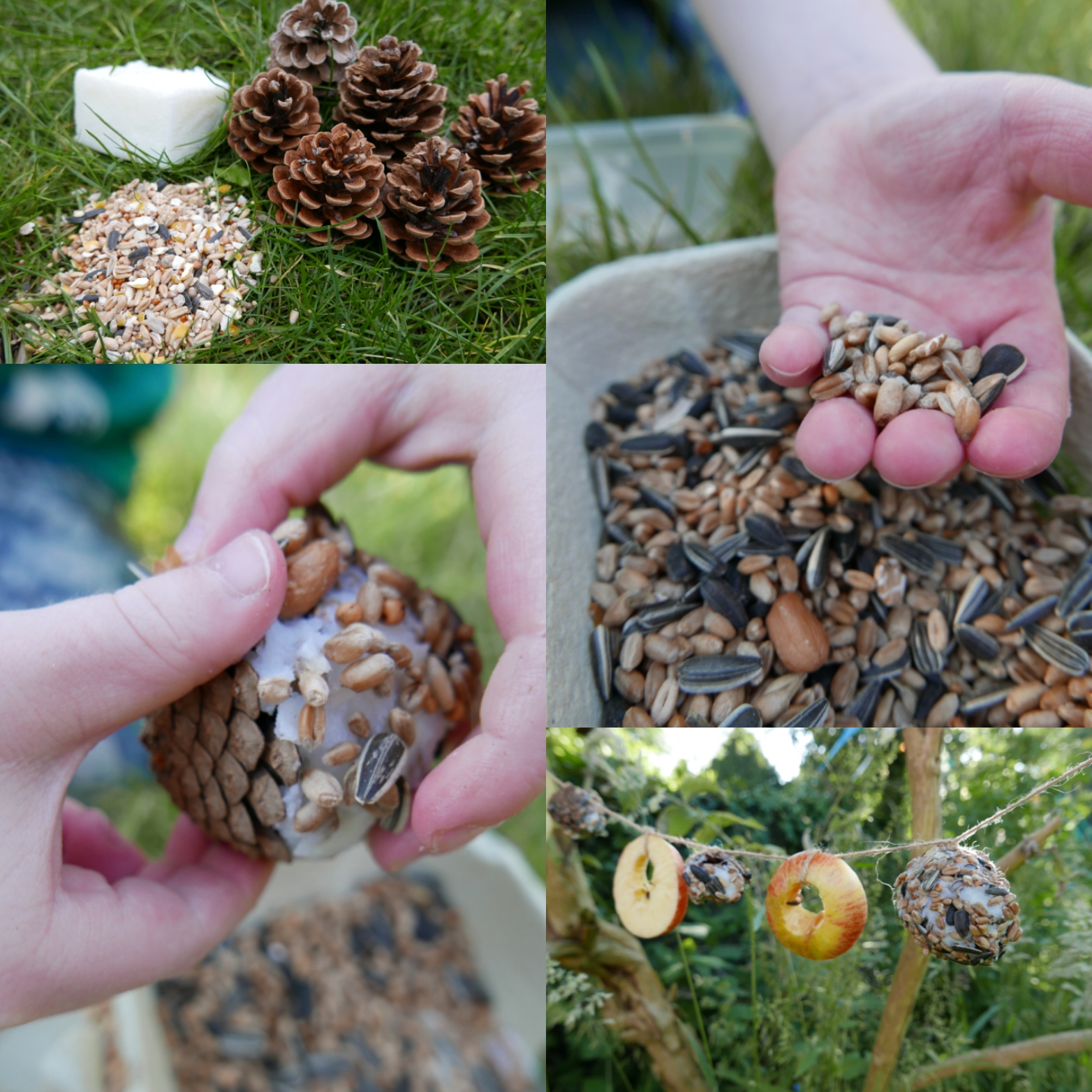
Birds need high levels of saturated fat to sustain them during the winter months which is why bird feeders are often made from suet or peanut butter as they are all great sources of saturated fat for birds. Simply cover the pine cones in the fat source and then roll them in the wild bird seed until they are fully covered. Next securely tie a piece of string to the top of your pine cones so you can hang them from a tree for the birds to enjoy.
19. Make a hedgehog house
How about making a hedgehog house or shelter for your garden. We simply used an old plastic box to make ours, we filled it with grass and leaves for nesting material and propped it up on bricks to allow room for the hedgehog to safely crawl in and out. But you can also buy or make wooden hedgehog shelters or create dens using logs and wooden boards leaving spaces for the hedgehogs to crawl into and ide under.

There are other ways you can help hedgehogs in your garden. Leaving out dishes of water in hot weather and making holes in and under fences to allow them to travel through gardens are the most useful.
Also avoiding using pesticides and making sure that ponds and water have ramps in them to allow any wildlife that falls in a way to climb out.
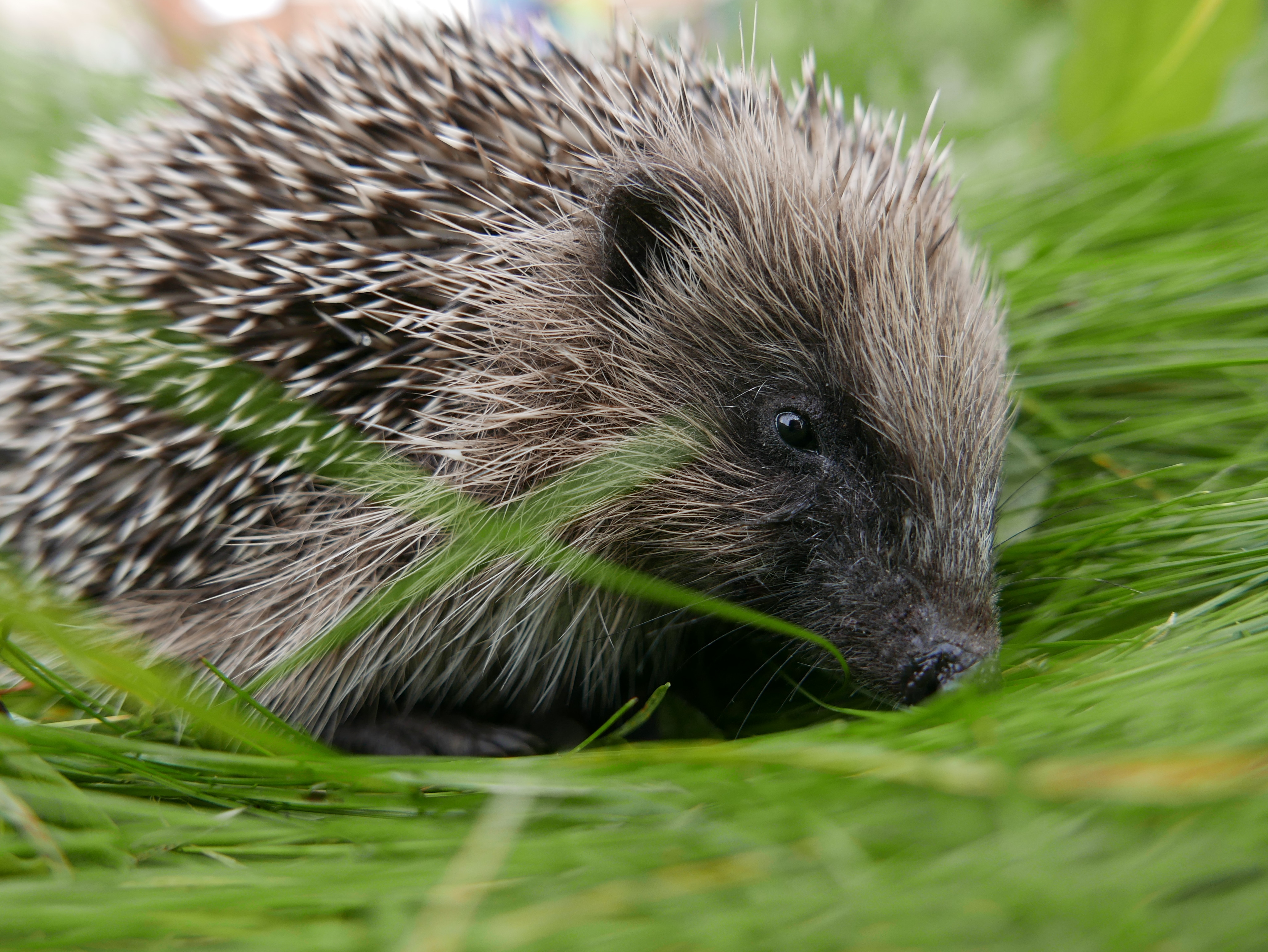
Did you know there are 17 species of hedgehog across the world! . Most of them are nocturnal which means they sleep through the day and are awake and active at night. Hedgehogs have poor eyesight so instead they rely on a highly developed senses of smell, touch and hearing to navigate the world around them. You can find lots of fun and easy hedgehog activity ideas for children of all ages here.
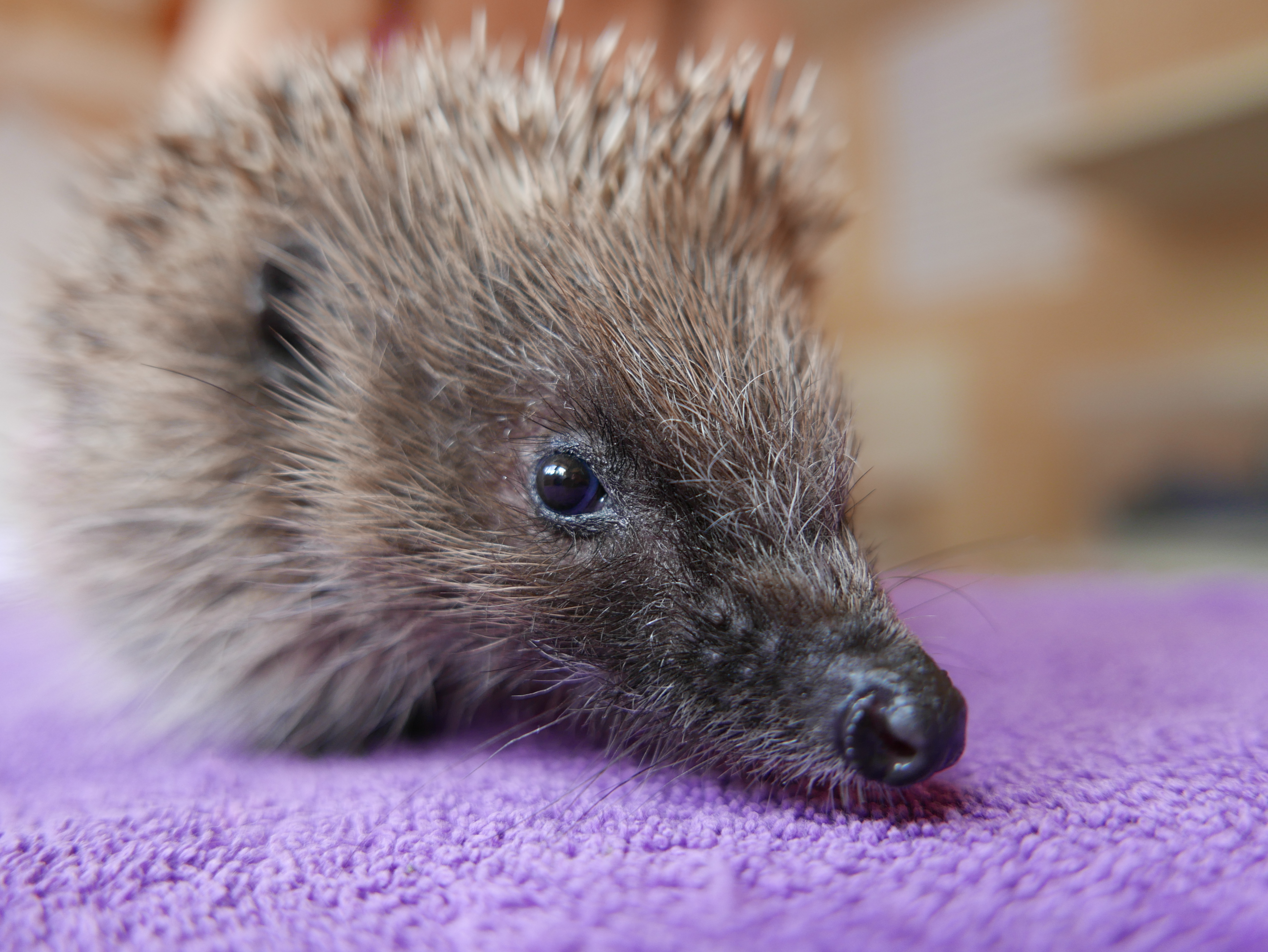
If you find or see a hedgehog out and about in the day or winter months then the best thing to do is observe it carefully. If it’s an adult moving with purpose and seems uninjured then its best to leave it be. However if it seems injured or distressed then it’s best to call your local vet or go to: https://www.britishhedgehogs.org.uk/found-a-hedgehog/ for advice and guidance.
20. Say NO to pesticides, harmful chemicals and pollution
We take our natural environment and gardens for granted they are actually an incredibly delicate ecosystems. Pesticides and chemicals kill wildlife as well as plants and the organisms living within soil making the soil itself essentially dead. Contaminated and dead soil takes 100’s of years to recover and there are already places in the world where the soil has died and turned into huge dust desserts where nothing lives or grows. By not using pesticides and chemicals in the garden you are protecting the soil, wildlife and ecosystem as a whole.

Plastic also poses a great risk to wildlife as they often mistake for food. To date plastics have been found in over 220 species, They can cause starvation and death for some animals as well as transferring toxic chemicals into the food chain. Worryingly enough micro plastics are already being found in human beings. If we all reduced the use of plastic in our daily lives we would greatly decrease the amount of plastic pollution in the environment.

Single use plastics are one of the biggest contributors to plastic pollution. By switching to environmentally alternatives you can avoid them entirely. For example using bamboo toothbrushes or cutlery rather than plastic ones or by wrapping food in beeswax wraps rather than clingfilm. There is now a whole world of environmentally friendly plastic free products and alternatives you can buy and use. It just takes a few minutes to search online and find helpful advice, guidance and groups to guide you in the right direction.
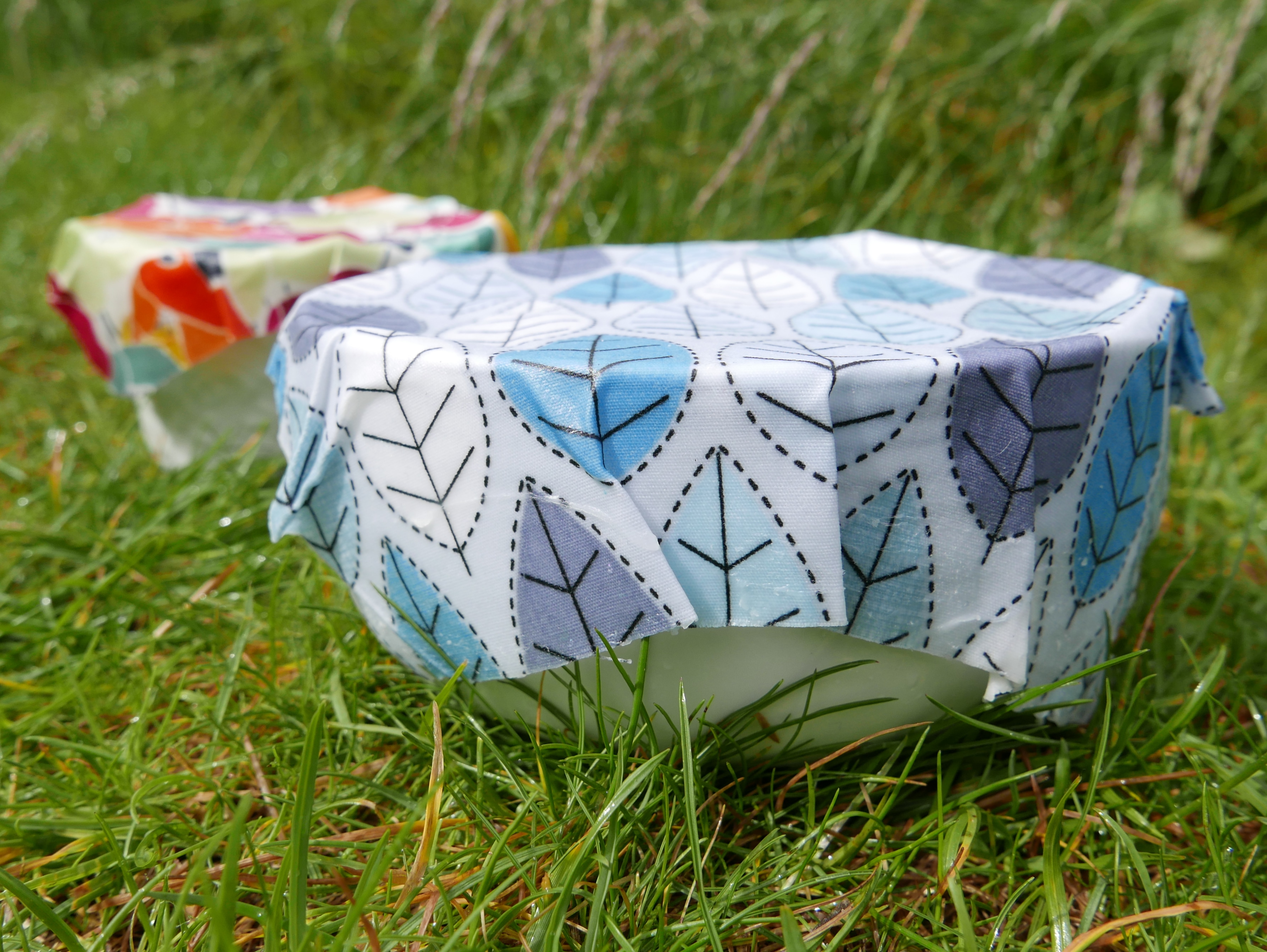
- For Day 1 of 30 Days Wild 2022 we planted trees, made an owl nesting boot, sowed wildflower seeds, explored a country park and found minibeasts.
- *For Day 26 of 30 days wild we made an amphibian shelter, sowed wildflower seeds, dug a ditch for wildlife and put up a butterfly house and feeder.
This page features in Twinkl’s Learning in Nature with Childsplayabc.

If you like this you might like to try:

20 Butterfly and caterpillar activities + fun facts

12 ideas for finding insects and minibeasts

10 Beetle activity ideas + fun facts


66 thoughts on “20 Ways to Make a home for wildlife”